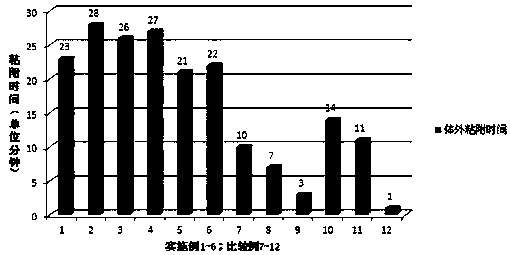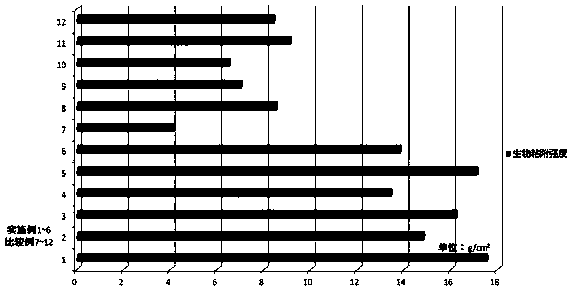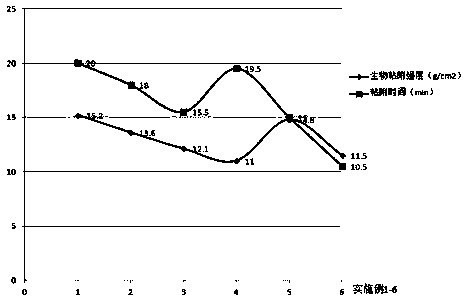A bioadhesive slow-release oral ulcer film and its preparation method
A bioadhesion and oral ulcer technology, applied in the field of medicine, can solve the problems affecting the action time of the film, short residence time, drug loss, etc., to achieve the effect of inhibiting the growth of wound bacteria, reducing the shaping process, and preventing wound infection
- Summary
- Abstract
- Description
- Claims
- Application Information
AI Technical Summary
Problems solved by technology
Method used
Image
Examples
preparation example Construction
[0041] A method for preparing a bioadhesive sustained-release oral ulcer film, the specific preparation steps are as follows:
[0042] 1) Prepare 580ml of solvent for every 100g of film. When the formula contains polylactic acid, polylactic acid-glycolic acid copolymer, and ethyl cellulose, use 45% ethanol for dissolution, and use purified water for dissolution when other components are contained. When the formula contains chitosan, add 10ml of glacial acetic acid, add the bioadhesive material and the slow-release film-forming material and stir until completely dissolved;
[0043] 2) Add the drug, plasticizer and support agent to the mixed solution in step 1) and stir to obtain mixed solution A;
[0044] 3) Use 20 ml of 75% ethanol to dissolve the bacteriostatic agent and flavoring agent per 100 g of the film to obtain a mixed solution B;
[0045] 4) Mix the mixed solution A and the mixed solution B, stir evenly, and obtain the standby liquid;
[0046] 5) The film-forming process of qu...
Embodiment 1
[0050] Prescription: per 100g film
[0051]
[0052]
[0053] Process: Take 580ml of purified water, add 10ml of glacial acetic acid, add chitosan, glucosamine, hydroxypropyl methylcellulose, and polyvinyl alcohol in sequence and stir until completely dissolved; add carbomer and acetic acid to the above solution in sequence Semisone, vitamin B6, traditional Chinese medicine extract, propylene glycol, glycerol, and talc are stirred to obtain mixed solution A; 20ml of 75% ethanol is used to dissolve the formula amount of antibacterial and flavoring agent to obtain mixed solution B; Mix with mixed solution B and stir evenly to obtain a standby liquid; the film-forming process adopts the method of quantitative titration with electronic discharge gun, one-time dripping into a cylindrical aluminum foil blister at a constant temperature of 30-70°C and drying for 15-90 minutes for preliminary film formation; Then put it into a constant temperature (20-50°C) and constant humidity (10%-70%...
Embodiment 2
[0055] Prescription: per 100g film
[0056]
[0057]
[0058] Process: Take 580ml of purified water, add 10ml of glacial acetic acid, add chitosan, methylcellulose and hydroxypropylcellulose in sequence and stir until completely dissolved; add vitamin B2, vitamin B6, vitamin C, and Lido to the above solution in sequence Caine, gentamycin, titanium dioxide powder and glycerol are stirred uniformly to obtain mixed solution A; 20ml 75% ethanol is used to dissolve the formula amount of antibacterial agent and flavoring agent to obtain mixed solution B; mix mixed solution A and mixed solution B. Mix and stir uniformly to obtain a spare liquid; the film forming process adopts the method of quantitative titration with an electronic discharge gun, one-time dripping into a cylindrical aluminum foil blister at a constant temperature of 30~70℃ and drying for 15~90min to form a preliminary film; put it in after the initial film is formed Constant temperature (20~50℃) and constant humidity (1...
PUM
 Login to View More
Login to View More Abstract
Description
Claims
Application Information
 Login to View More
Login to View More - R&D
- Intellectual Property
- Life Sciences
- Materials
- Tech Scout
- Unparalleled Data Quality
- Higher Quality Content
- 60% Fewer Hallucinations
Browse by: Latest US Patents, China's latest patents, Technical Efficacy Thesaurus, Application Domain, Technology Topic, Popular Technical Reports.
© 2025 PatSnap. All rights reserved.Legal|Privacy policy|Modern Slavery Act Transparency Statement|Sitemap|About US| Contact US: help@patsnap.com



